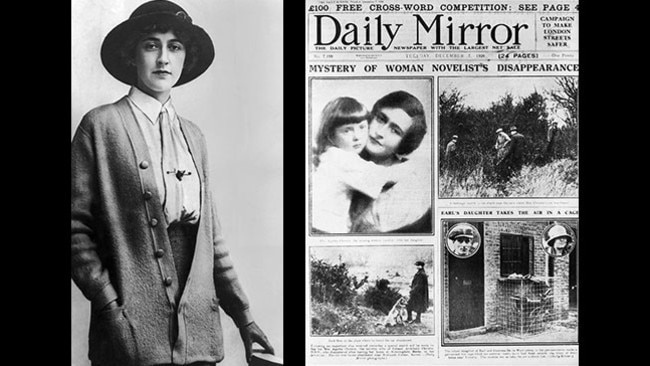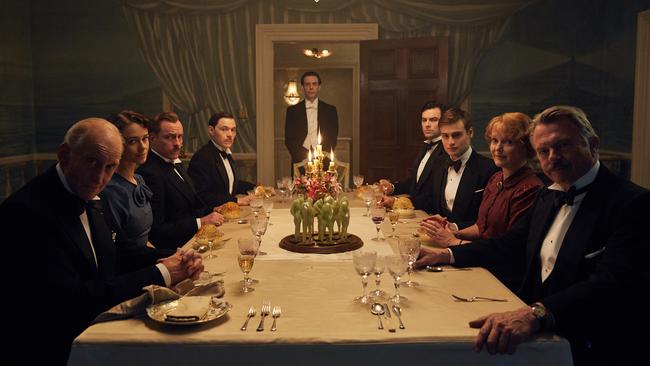Agatha Christie: mysterious disappearance adds fuel to her renaissance
With the release of TV and film adaptations of her work, Agatha Christie is now cool. Yet one puzzle stays unsolved.

More than 40 years after her death, Agatha Christie is enjoying a renaissance. Not only are her books more popular than ever, the queen of crime — too often associated with wooden amateur drama productions and snooze-inducing teatime viewing — might even be considered cool.
After the success of Sarah Phelps’s hard-hitting television adaptations of And Then There Were None and The Witness for the Prosecution, the BBC has commissioned seven more Christie dramas, including Ordeal by Innocence and The ABC Murders. There is also a sense of anticipation among fans about the release later this year of the cinema version of one of Dame Agatha’s darkest novels, Crooked House, with a screenplay by Julian Fellowes and starring Christina Hendricks, Glenn Close, Gillian Anderson, Max Irons and Terence Stamp. It is the novel’s first screen adaptation, and its shocking ending is likely to surprise anybody who thinks of Christie as comforting and cosy.

In November, Kenneth Branagh’s film version of Murder on the Orient Express is released. The director plays Hercule Poirot, Christie’s famous Belgian detective, and the starry cast includes Judi Dench, Derek Jacobi, Penelope Cruz and Johnny Depp. It has also been reported that there are two Hollywood biopics in the works, one starring Alicia Vikander, the other with Emma Stone as the 30-something Agatha when she disappeared for 10 days in the winter of 1926.
It was this real-life incident that inspired my new novel, A Talent for Murder. On December 3, 1926, the author left the comfortable Berkshire home she shared with her unfaithful husband, Archie, and their seven-year-old daughter, Rosalind, and drove to an isolated beauty spot in Surrey, where she abandoned her car. When the police found the vehicle the next day, with her driving licence and fur coat inside, they launched an enormous manhunt that enlisted the services of more than 15,000 volunteers.
The detective in charge, William Kenward, suspected Christie had been murdered by her husband, who had been having an affair with a younger woman, an attractive brunette named Nancy Neele. But 10 days later the novelist — already famous for her thrilling book The Murder of Roger Ackroyd — turned up at a hotel in Harrogate, Yorkshire, having registered under the name Mrs Neele. A statement was released saying she had suffered an attack of amnesia. She refused to speak of the incident ever again, omitting it from her posthumously published autobiography.
As a biographer whose subjects have included Patricia Highsmith, Sylvia Plath and Alexander McQueen, I had long been intrigued by the story, but knew there was insufficient material for a sustained piece of nonfiction. I decided to take the bare “facts” of the case — from witness statements and newspaper accounts — and imagine a scenario that would explain her bizarre behaviour. Was someone blackmailing her? What if this person wanted her to kill on their behalf? As one of my characters says to her: “You, Mrs Christie, are going to commit a murder. But before then you are going to disappear.”
The real-life scandal was almost certainly Christie’s personal nadir, but as The New Yorker’s Joan Acocella writes: “Her disappearance, with its interesting link to detective fiction, made her a celebrity.” The intrigue around the story continues to lend Christie a certain mystique. In 2014, Newsweek magazine dubbed her “the original Gone Girl”, after Gillian Flynn’s bestselling novel and blockbuster film.
Flynn, a self-confessed Christie fan, is not the only contemporary crime writer to take inspiration from the author. It’s clear that Paula Hawkins drew on Christie’s 1957 novel 4:50 from Paddington for the premise of The Girl on the Train, while Clare Mackintosh, a former police officer and author of the bestselling I Let You Go and I See You, cites Christie as a key influence. “A crime novel is a game,” she says, “a challenge thrown down by the author to the reader. Can the reader solve the crime before the author reveals the truth? Agatha Christie’s mysteries may be formulaic, but that formula is successful, enjoyable and satisfying.”
Our passion for puzzles explains our enduring love for Christie’s fiction, believes Anthony Horowitz, who has adapted several Poirot novels for TV, and whose Magpie Murders, a metafictional riff on Christie, was published last year. “She is a good writer, not a great one, but she had an extraordinary ability to make patterns that surprise and baffle,” he says. “All fiction is the search for truth, and no one does it better than her.”
One of the tropes of crime fiction, particularly from the “golden age”, is the closed environment, whether it’s an island (And Then There Were None, A Caribbean Mystery), a river boat (Death on the Nile), a snowbound train (Murder on the Orient Express) or a grand country house (too many to mention). The setting is always key in Christie.
“What Agatha is particularly good at, I think, is conveying a sense of stifled luxury,” says Ruth Ware, author of In a Dark, Dark Wood, The Woman in Cabin 10 and the upcoming The Lying Game. “Her characters are supposed to be having a wonderful time, but in reality they are trapped in a claustrophobic nightmare.”
Since the publication in 2015 of In a Dark, Dark Wood — which is being made into a film by Reese Witherspoon — Ware has been asked often whether she minds being compared to Christie. “It’s almost as if it was slightly degrading and declasse,” she says. “The truth is, I am more than flattered, as Agatha was such a brilliant plotter.”
It has been easy to dismiss Christie’s novels as the literary equivalent of Cluedo, populated by cardboard-thin characters and stitched together by a string of cliches. This stance was epitomised by the American critic Edmund Wilson, writing in The New Yorker in 1944, who believed one should have outgrown what he regarded as the rather inferior form of the detective novel by the age of 12. Holding his nose, he forced himself to wade through a number of contemporary crime novels and pronounced Christie distinctly substandard.
She still has her fair share of detractors. In 2015, The Irish Times quoted John Banville as saying that while he regarded Christie as some kind of genius, she would have been better employed as a code-breaker at Bletchley Park than as a novelist. Her characters, he said, were nothing better than marionettes, “jerking lifelessly on the ends of their all-too-visible strings”. And her worst fault? “We never feel the slightest twitch of sympathy for, or empathy with, the victim, lying there in the library in a neat puddle of blood. Who could possibly care?”
Perhaps Banville — who, under the name Benjamin Black, is the author of the Quirke crime series — has not read Christie’s poignant A Pocket Full of Rye (1953). One of the victims is a former maid of Miss Marple’s, a domestic servant named Gladys Martin, who is strangled by a man she trusts and left with a clothes peg on her nose. When Miss Marple hears of the brutal murder, she goes to the home of the wealthy Fortescue family to investigate. Although she works out the identity of the killer, she has no definite proof and has to return home to St Mary Mead. There she finds a letter Gladys had written before her death, a document that also contains a snapshot of the girl’s lover. Finally, Marple has everything she needs to bring the cold-hearted killer to justice.
The reader reacts to the revelation with the same level of sympathy as Miss Marple, who feels tears welling. “Succeeding pity, there came anger — anger against a heartless killer,” Christie writes. “And then, displacing both these emotions, there came a surge of triumph — the triumph some specialist might feel who has successfully reconstructed an extinct animal from a fragment of jawbone and a couple of teeth.”
At her best, Christie seduces her readers, enveloping them in a deceptively simple comfort blanket of nostalgia before jolting them awake with a detail — such as the clothes peg on the nose — so disturbing, it sends shockwaves through the text. As Sophie Hannah, author of two Poirot continuation novels, has observed, Christie’s books are “light and jolly and fun to read, but also constantly aware of the dangerous lure of evil”.
“All along, she has appealed to nearly everyone,” says Jamie Bernthal, co-organiser of a Christie conference at the University of Cambridge next month. “She’s read in most languages by nearly all age groups, regardless of socioeconomic background.”
It seems the self-deprecating Christie, who described herself as something of a “sausage machine”, is finally getting the serious attention she deserves.
“The conference is a statement of intent — we want to establish Agatha Christie studies as an academic discipline with its own identity,” Bernthal says. “We are saying, ‘Look, Christie has arrived. She’s a writer who deserves to be studied, and we need to take that study seriously.’ ”
Christie is rated the bestselling author of all time by Guinness World Records, with two billion sales from 66 novels and 14 short-story collections. She is also ranked the third most widely published, after Shakespeare and the Bible, and the most translated, appearing in 103 languages.
Her first novel, 1920’s The Mysterious Affair at Styles, sold 2000 copies in its first edition, according to the website poirot.us. That figure rose to 5000 for The Murder of Roger Ackroyd in 1926. The first edition of her 50th novel, 1950’s A Murder is Announced, sold 50,000.
Her biggest seller is 1939’s And Then There Were None, at 100 million-plus copies to date. It is ranked the seventh bestselling book of all time. The novel rated second favourite with fans, 1934’s Murder on the Orient Express, is claimed to have notched up three million sales in 1974 alone, the year it was made into a film with Albert Finney as Poirot.
Andrew Wilson’s A Talent for Murder is out on Thursday (Simon & Schuster, $39.99). And Then There Were None screens on Foxtel’s BBC First.


